External links
- UNESCO
- "World Heritage In Korea" (PDF). Cultural Heritage Administration. Archived from the original (PDF) on 2007-09-30.
| Sites of fossilized dinosaurs across the southern South Korean coast | |
| Hangul | 남해안일대공룡화석지 |
|---|---|
| Hanja | 南海岸一帶恐龍化石地 |
| Revised Romanization | Namhaean ildae gongnyonghwaseokji |
| McCune–Reischauer | Namhaean iltae kongnyonghwasŏkchi |
The sites of fossilized dinosaurs across the southern South Korean coast is a tentative UNESCO World Heritage site registered by the South Korean government since 2002. Although the evidence is rare,fossils reveal that there were dinosaurs in South Korea. The ancient remains of dinosaurs are located within a beautiful display of nature that includes petrified wood,the tracks of extinct dinosaurs and other animals,the exposure of geographic rock layers,and particular river drifts. This dinosaur park is well protected by the local governments and by the Marine National Park and is an invaluable resource for understanding the ecosystem and nesting behaviors of dinosaurs of the Mesozoic era.
The largest sites of fossilized dinosaur eggs and footprints of dinosaurs from the Cretaceous period of the Mesozoic era in the world are located in various sites along the southern seacoast of South Korea. Fossilized eggs are widely distributed and are in well preserved conditions. Additionally,the footprints of two webbed-feet/birds are also some of the oldest of its kind to be discovered.
The Haenam-gun site is most famous for the footprints of giant dinosaurs discovered there. This site,the first in Asia,also preserves the footprints of webbed-feet birds that once walked along the shores. This site is South Korean Natural Monument No. 394.
Dinosaur nests,measuring at 1.5 meters in diameter,and fossilized eggs are perfectly preserved at the Boseong-gun site. This site is South Korean Natural Monument No. 418.
The city of Yeosu and the islands of Sado,Choodo,Nangdo,Jeokgeumdo,and Mokgeumdo are famous for the many fossils from the Cretaceous period. This area is particularly famous for a trail of footprints that measures 84 meters in length. This site is designated as Monument of Jeollanam-do No. 199.
The Goseong-gun site is famous for the number and variety of fossils excavated and includes 4,000 dinosaur footprints and paleontologists have identified over 420 different walking trails there as well. This site is South Korean Natural Monument No. 411.
The site has been selected as the country's candidate for World Heritage listing for 2009,under the name Korean Cretaceous Dinosaur Coast. [ permanent dead link ]

South Jeolla Province, also known as Jeonnam, is a province in the Honam region, South Korea, and the southernmost province in mainland Korea. South Jeolla borders the provinces of North Jeolla to the north, South Gyeongsang to the northeast, and Jeju to the southwest in the Korea Strait.

Yeosu, is the second largest city in South Jeolla Province, South Korea. In 1998, the Old Yeosu City, Yeocheon City and Yeocheon County were merged and the current city, Yeosu, was formed. Historically it was known as Yosu, and Reisui during the Japanese rule over the Korean peninsula.
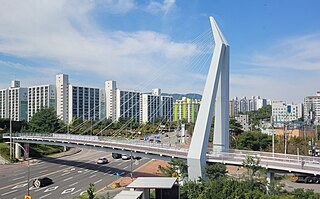
Suncheon (Suncheon-si) is the largest city in Jeollanam-do, South Korea, with a population of 280,719 as of 2022. It is located in the southeast of the province and is a scenic agricultural and industrial city, known for tourist attractions, such as Suncheon Bay. The port city of Yeosu is around forty minutes south of Suncheon and Gwangyang twenty minutes to the east of the city.

Uiseong County (Uiseong-gun) is a county in Gyeongsangbuk-do Province, South Korea. Located near the center of the province, it is bounded by Andong on the north, Cheongsong on the east, Gunwi County on the south, and Sangju and Yecheon on the west. As in most parts of Korea, most of the land is vacant and forested; only about 19% of the county's area is farmland. The county is largely rural, with an economy dominated by agriculture; the only urbanized area is the county seat, Uiseong-eup.
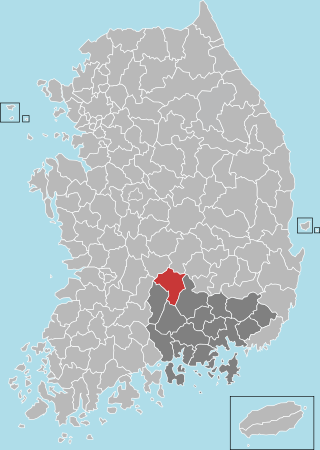
Geochang County is a county in South Gyeongsang Province, South Korea. The Geochang International Festival of Theater, which was started in 1989, is renowned as the best play festival in Korea. The District Office is located in Geochang-eup, and has jurisdiction over 1 eup and 11 myeon.
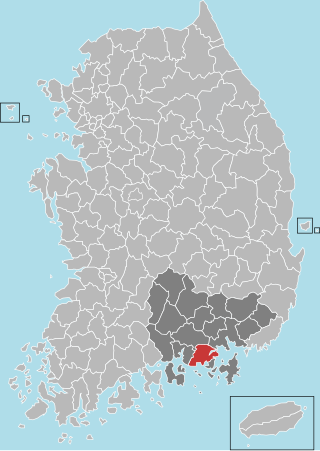
Goseong County (Goseong-gun) is a county in South Gyeongsang Province, South Korea

The Gochang, Hwasun and Ganghwa Dolmen Sites are the location of hundreds of stone dolmens which were used as grave markers, and for ritual purposes during the first millennium BCE when the Megalithic Culture was prominent on the Korean Peninsula. The sites were designated as a World Heritage Site by UNESCO in 2000. The Korean Peninsula is home to over 35,000 dolmens, accounting for approximately 40% of the world's total; the Gochang, Hwasun, and Ganghwa sites are themselves home to over 1,000 dolmens.

A fossil track or ichnite is a fossilized footprint. This is a type of trace fossil. A fossil trackway is a sequence of fossil tracks left by a single organism. Over the years, many ichnites have been found, around the world, giving important clues about the behaviour of the animals that made them. For instance, multiple ichnites of a single species, close together, suggest 'herd' or 'pack' behaviour of that species.

Suncheon Castle, also known as Suncheon Waeseong, in Korean, Juntenjō (順天城) in Japanese, is the only remaining Japanese castle in Jeollanam-do, and the battlefield of Yi Sun-sin who tempted Konishi Yukinaga from here to Noryang Point known as Battle of Noryang Point.
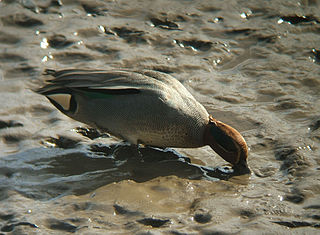
Bird ichnology is the study of avian life traces in ornithology and paleontology. Such life traces can include footprints, nests, feces and coproliths. Scientists gain insight about the behavior and diversity of birds by studying such evidence.
The Goseong Dinosaur Museum is in South Korea. The museum presents dinosaur footprint fossils.
The Uhangri Formation, located at the Uhangri Dinosaur Fossil Site, is a geological formation from which fossil pterosaur tracks have been recovered near Haenam-eup, Jeollanam-do, South Korea.

Koreanosaurus is a genus of orodromine neornithischian dinosaur. One species has been described, Koreanosaurus boseongensis.
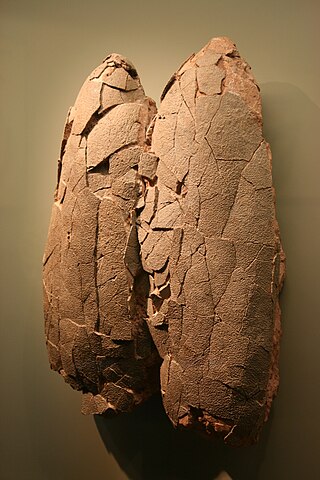
Macroelongatoolithus is an oogenus of large theropod dinosaur eggs, representing the eggs of giant caenagnathid oviraptorosaurs. They are known from Asia and from North America. Historically, several oospecies have been assigned to Macroelongatoolithus, however they are all now considered to be a single oospecies: M. carlylensis.
Hadang (Korean: 하당신도시) is the newly built urban area in Mokpo, Jeollanam-do of South Korea, which aims at accommodating increased population near Muan International Airport and movement of the provincial office. Before announcement of the transfer of office, Mokpo city initially intended to rebuild another area for housing. The project was finalized so until 1999 most of area was leased for marketing, business, housing, and preliminary purpose.
Suncheon Junction, shortly Suncheon JC, is a junction located in Seo-myeon, Suncheon, South Jeolla, South Korea. Namhae Expressway and Suncheon–Wanju Expressway meet here. The type of junction is deleted turbine.
Yulchon-myeon, also called Yulchon Township, or shortly Yulchon, is a myeon (township) in Yeosu city of South Jeolla Province, South Korea. The myeon is located in the north-western part of the city. The total area of Yulchon-myeon is 46.5 square kilometers, and, as of the last day of 2010, the population was 7404 people. It has Yeosu Airport in Sinpung-ri. Township hall is located in Johwa-ri. Sora-myeon is to the south and Haeryong-myeon, Suncheon to the north, Gwangyang-eup, Gwangyang is to the north-east, Suncheon Bay and Yeoja Bay to the west, and Gwangyang Bay is to the east.

Sora-myeon, also called as Sora Township, or shortly Sora, is a myeon (township) in Yeosu city of South Jeolla Province, South Korea. The myeon is located in center-western part of the city. The total area of the myeon is 60.5 square kilometres, and, as of the last day of 2010, the population was 12256 people, 5195 houses. The township hall is located in Deogyang-ri. Hwayang-myeon is south and Yulchon-myeon, is north, Samil-dong and the Gwangyang Bay is north-east, Jusam-dong and Yeocheon-dong is east, Ssangbong-dong is south-Easter, and the Yeoja Bay is west.

Hwayang-myeon, also called as Hwayang Township, or shortly Hwayang, is a myeon (township) in Yeosu city of South Jeolla Province, South Korea. The myeon is located in south-western part of the city. The total area of the myeon is 70.1 square kilometres, and, as of the last day of 2010, the population was 8108 people, 3559 houses. The township hall is located in Najin-ri, and address of the township hall is 16-10, Najin-gil, Hwayang-myeon. Hwajeong-myeon and Jangsu Bay is southern section, Sora-myeon is northern section, Ssangbong-dong is north-eastern section, the Gamak Bay is eastern section, and the Yeoja Bay is western section.